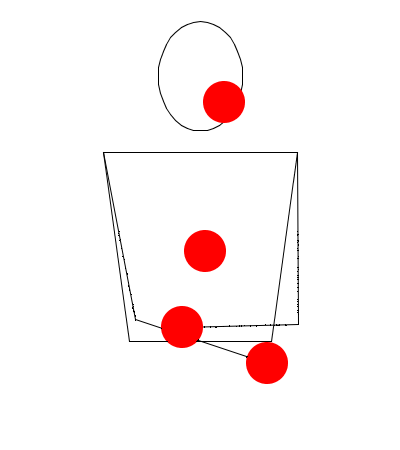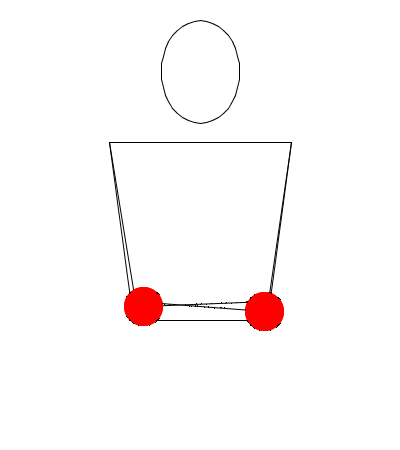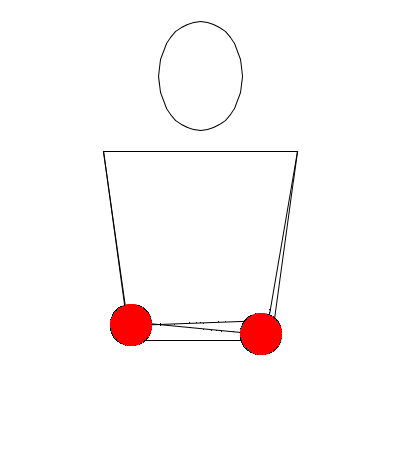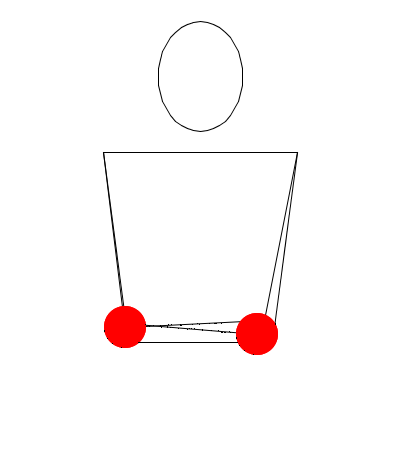Tennessee Waltz
Other Tutorials:
- Siteswap: 3[32T]
- Difficulty (1-10): 6
- Prerequisites: Cascade, Cliff's Confusion (optional)

The Tennessee Waltz is a four
ball multiplex pattern reminiscent of Mills Mess. It contains three distinct
cycles, each one containing a Cascade/multiplex throw pair but with
different arm positions and direction. I found the obscure Tennessee Waltz
on a
website run by Todd Strong, which contained no information regarding the
pattern's popularity or inventor. However, it does bear a similarity to
Cliff's Confusion, so the same individual may have had a hand in creating
both patterns.
To learn the Tennessee Waltz, it is best to begin with the
first cycle, and then add in the next two as you go along. Start with two
balls in each hand, and then cross your dominant hand underneath your
non-dominant hand (you could cross them in the opposite configuration if you
wanted, but you will need to reverse the dominant and non-dominant hands
whenever an instruction is given). Make a fairly vertical throw from your
dominant hand, and then throw a stacked multiplex from your non-dominant
hand while simultaneously uncrossing your arms. You will then catch the
lower multiplexed ball with your non-dominant hand, and then reach up and
grab the top multiplexed ball with your dominant hand as it begins to come
back down.
Practice this until your are comfortable with the two throws.
To add in the second cycle, you are going to make a throw from your dominant
hand as it reaches up to grab the top multiplexed ball. You will then make
an under-the-arm stacked multiplex from your non-dominant hand, clearing
space for the ball just thrown from your dominant hand to be caught. You
will then catch the bottom multiplexed ball with your non-dominant hand, and
then reach over and grab the top multiplexed ball with your dominant hand
(just as you did for the previous cycle).
Again, practice these throws until you can do them
consistently. To add in the third and final cycle, you are going to make a
throw back across your body from your dominant hand while it is crossed over
your non-dominant hand. You will then catch the top multiplexed ball with
your empty dominant hand, which should be uncrossing. As the ball just
thrown from your dominant hand approaches your non-dominant hand, you will
make a stacked multiplex from your non-dominant hand, clearing space for the
ball to be caught. You will catch the bottom multiplexed ball with your
non-dominant hand, and then cross your dominant hand underneath your
non-dominant to catch the top multiplexed ball.
Practice all three of the cycles extensively. To begin a new
set of cycles, you simply need to make an under-the-arm throw from your
dominant hand before it catches the top multiplexed ball from the third
cycle. This will set you up to make a multiplex from your non-dominant hand
identical to the one thrown in the first cycle. The Tennessee Waltz is not a
particularly difficult pattern, but it will take some practice to perfect
the multiplexes.
